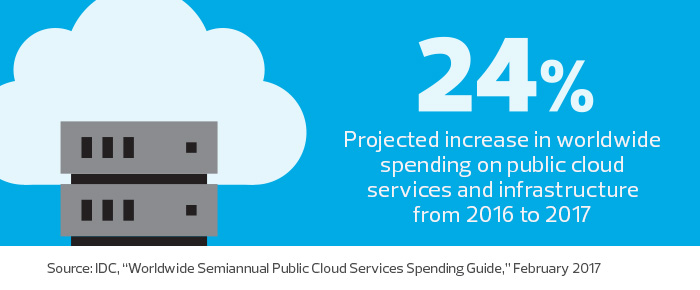Agencies Eye the Advantages of a Move to the Cloud
In Arizona, a new agency director recently asked the state’s IT leaders for a massive database to help with budgeting decisions. Getting him up and running with on-premises resources would have set the work back by months.
“We would have had to obtain three quotes, place the order and wait for the trucks to show up,” says Arizona CIO Morgan Reed. “It probably would have taken 90 days, at the earliest, before he could start.”
Instead, the state turned to cloud-based resources and delivered the director the tools he required, practically overnight.
“We spun the database up in the cloud in a day, the department did what they needed to do, and a month later we shut it down,” says Jason Simpson, the state’s CTO. “That wouldn’t have happened in the past.”
Arizona has adopted a cloud-first strategy, moving applications, data and infrastructure to the public cloud. The state uses cloud communications tools such as Slack; cloud cybersecurity tools, including Cylance and RiskSense; and Jira, a cloud-based project development software. While some agency stakeholders initially expressed skepticism, Reed and Simpson say the strategy has led to new efficiencies, lower costs and faster delivery of services.
So far, data doesn’t show a clear trend toward a widespread move to the cloud among governments, says Brian Hopkins, vice president and principal analyst at Forrester. The reasons for that range from security concerns to the presence of complex, on-premises legacy systems. But anecdotally, Hopkins says, conversations around the cloud have shifted.
“I think attitudes are changing,” he says. “We’re at a pivot point.”
SIGN UP: Get more news from the StateTech newsletter in your inbox every two weeks
Top Public Sector Cloud Drivers
Cloud solutions uniquely suit some aspects of the public sector. For instance, procurement procedures for capital expenditures can be cumbersome and slow, whereas funding cloud deployments as an operational expenditure allows greater flexibility.
“Government, traditionally, moves at a pace that is not conducive to rapid change,” Simpson says. “Now, agencies have the opportunity to try things. They can spin up a couple of servers and try something, and if it doesn’t work, they can shut it down.”
Some IT administrators say that moving resources off-premises can improve data compliance and security.
“From a compliance and standards perspective, you can put the burden and cost of compliance on your cloud partners,” says Mark Combs, CTO for Vermont’s Agency of Digital Services. “You’re trusting, but verifying — but you don’t have to go through the whole audit yourself. Once you have your standards defined, and those are generally federal or industry standards, it’s easier to identify cloud providers who can meet those standards. They’re getting audited for compliance themselves these days.”

As in other industries, the desire to reduce physical data center space, optimize IT utilization, and eliminate the maintenance and management costs associated with physical hardware also plays a large role in states’ and cities’ decisions to move to the public cloud.
“Fiscal responsibility was our largest driver for the development of cloud-based solutions,” says Wyoming CIO Tony Young. The state deployed Microsoft Azure’s StorSimple and moved email to the cloud with G Suite. Young encourages agencies to move applications to Software as a Service whenever possible to reduce hardware and staffing needs.
“Technology solutions duplicated throughout agencies, and the associated licensing, represented a significant budgetary line item that we could address, generating an almost immediate cost savings,” he says.
In Arizona, an aging data center compounded the challenges of maintaining physical hardware. The state government’s last three IT outages resulted not from equipment failure, but from facilities issues, Reed says. Arizona has since allocated funding for a new data center, but the downtime illustrates the potential pitfalls of on-premises hardware.
“Many of our physical servers are aging out,” Simpson says. “We’re not adding value for the citizens of Arizona, or anybody else, in trying to maintain a bunch of hardware.”
Best Practices for a Smooth Cloud Migration
For organizations that historically have resisted cloud migrations, it’s helpful to start with a relatively simple project, such as data backup, Simpson advises.
“That’s a good way to dip your toe in the water, and then you start moving other things,” he says.
For Vermont, moving email to the cloud is the low-hanging fruit that will pave the way for more complicated migrations, Combs says. The state rolled out Office 365 for email after extensive pilots, and upgraded its enterprise resource planning system, PeopleSoft, to the final on-premises release in preparation for a future cloud-based system.
Organizations should evaluate resources on a case-by-case basis, rather than migrating them to the cloud by default, Combs says: “I can’t imagine anybody going to 100 percent commercial cloud. It’s going to be a hybrid.” Migrating resources may require IT staff to rearchitect systems to optimize them for the cloud, Hopkins says: “I think the biggest roadblock is understanding that it’s not just a lift and shift.”

Ultimately, good communication drives successful migration, says Michael Mattmiller, CTO for the city of Seattle, which uses Microsoft Dynamics 365 for correspondence management, among other cloud tools. Specific departments or agencies may have data security concerns, and it’s important to educate these users about the security features of the new deployment, Mattmiller says.
“Naturally, when you have a new type of functionality, it raises questions,” he says. “We spent a good amount of time educating users about how we were protecting their data."
Fortunately, users often find the functionalities enabled by the cloud appealing, Mattmiller says. For example, when Seattle had on-premises email, users needed a separate archiving system to search for emails older than 90 days. The move to the cloud eliminated that step.
Managers should also explain to IT workers how they’ll fit into the new model, Reed says.
“We’ve moved 400 servers to the cloud in the past six months. It’s definitely a journey. Our IT workers are learning on that journey as well. We’re not getting rid of them. They’re learning new skills, and they’re applying that knowledge up the stack a little bit,” he says. “We want folks to grow along with us on that journey.”









